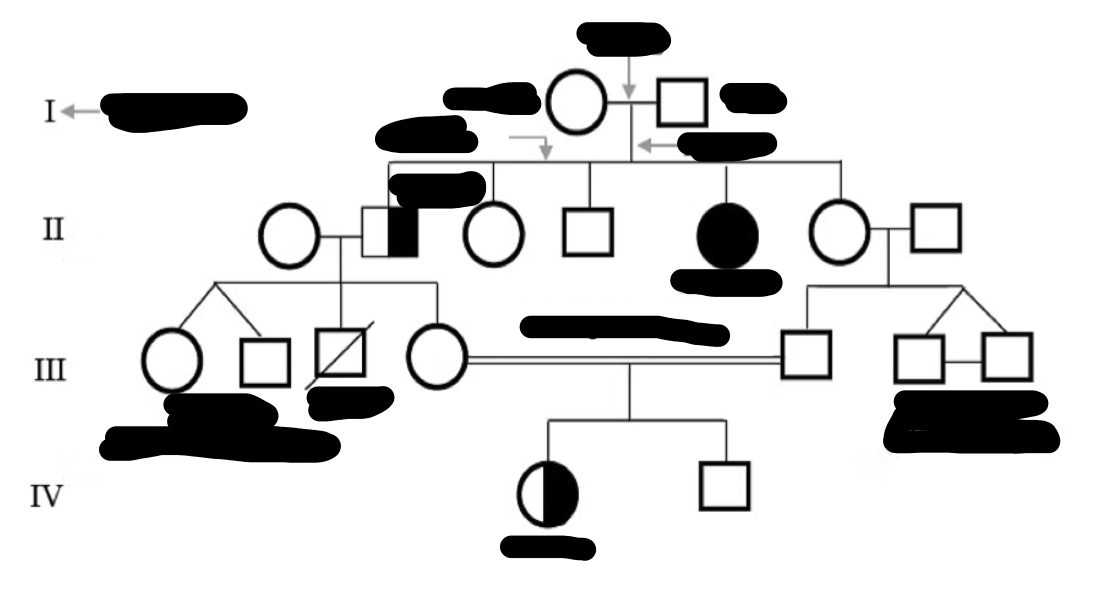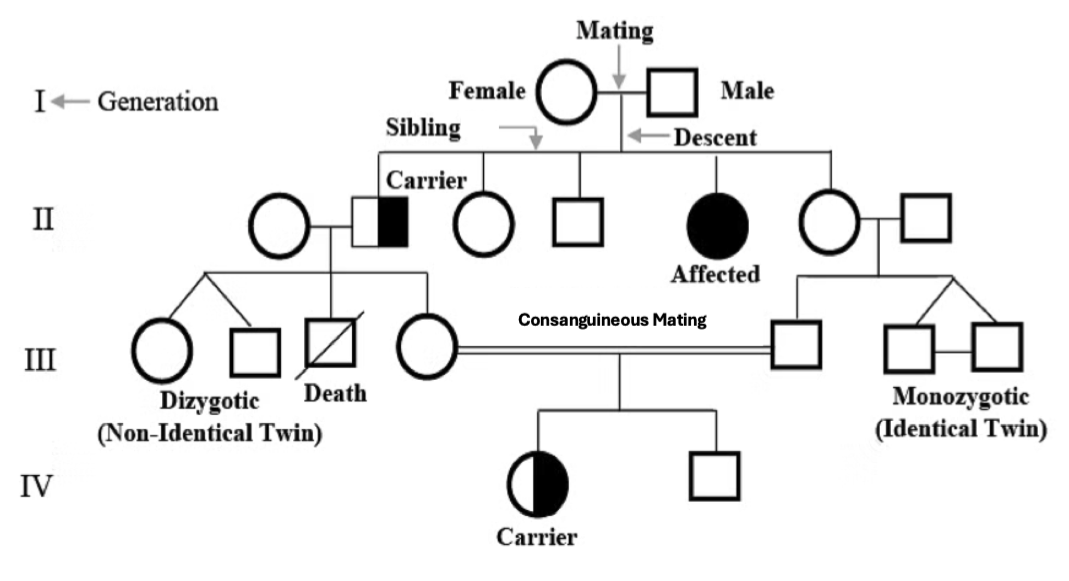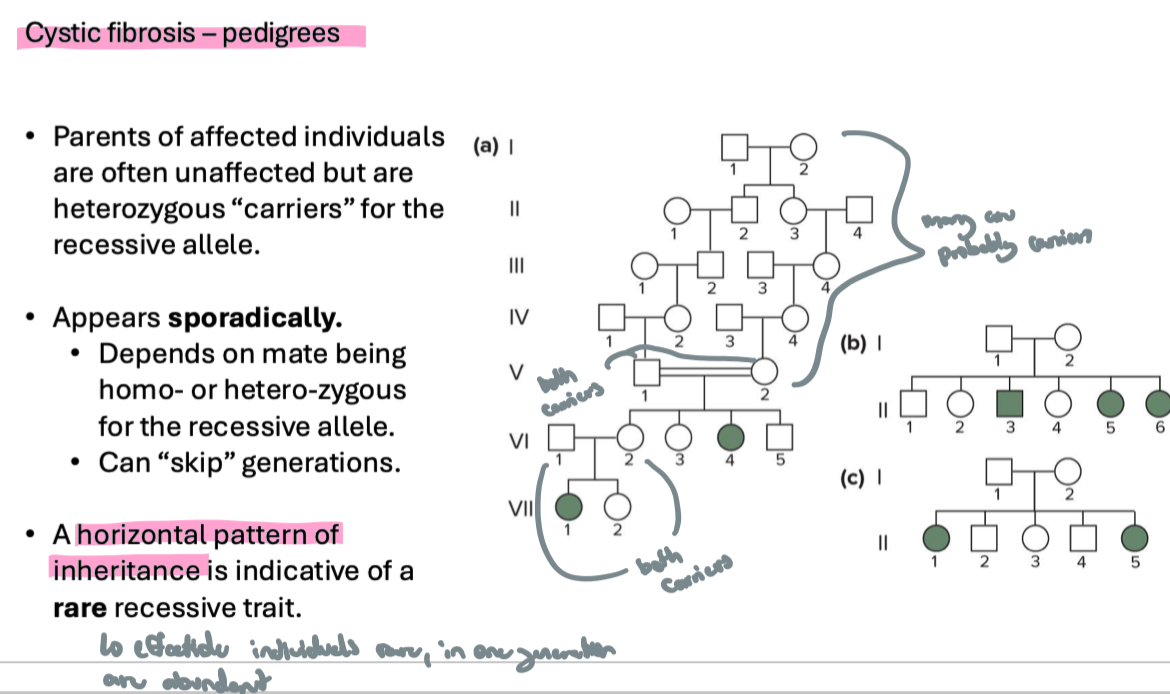Lecture 5: Pedigree Analysis
1/50
There's no tags or description
Looks like no tags are added yet.
Name | Mastery | Learn | Test | Matching | Spaced |
|---|
No study sessions yet.
51 Terms
T/f: can test crosses be used to determine inheritance patterns
t: yes BUT can’t be used to study human gene inheritance
what are the four possible modes of inheritance of a trait that are controlled by a single gene:
autosomal dominant
autosomal recessive
sex-linked dominant
sex-linked recessive
t/f: can test crosses be done for humans
no → can’t morally selectively breed humans
t/f: can punet squares be used for humans
yes → can still use punnet squares for humans just not test crosses
what is used to study inheritance patterns in humans
pedigrees
what are pedigrees
used to study inheritance patterns in humans
basically a diagram of family’s relevant genetic features (looks like family tree)
keeps record of matings and genetic conditions
how are pedigrees analyzed
using Mendel’s laws
how are Mendel’s laws used Mendel’s laws used to analyze pedigrees
is a trait determined by alternate alleles of a single gene
is a trait dominant or recessive

do these symbols mean
diff symbols for people who are carriers → heterozygous for a recessive trait

what do these symbols mean
unaffected…
male
female
sex unspecified

what do these mean
male, female, sex unspecified have multiple progeny (offspring)

male deceased, female deceased

consanguineous mating → mating btwn closely related individuals (can increase probability of certain diseases occurring so is kept track of)

sibship line
line of descent
individual number w in generation
generation 2
mating line
generation 1


monozygotic
affected
sibling
male
female
mating
descent
dizygotic
death
carrier
generation
carrier
consanguineous mating

what are some differences btwn breeding experiments and pedigrees
breeding experiments
inbred bloodlines (P, F1, F2, etc.)
no “new” individuals introduced"
pedigrees
new individuals added each generation
not everyone in pedigree is a descendant of someone else in the pedigree
many human traits run in families, but most do not show simple mendelian inheritance. Why?
most human traits are not determined by a single gene
most confirmed single-gene traits in humans are rare
even with single-gene traits, determining inheritance patterns in humans can be challenging compared to peas. Why?
environmental effects
human’s don’t produce hundreds or thousands of offspring
what are mendel’s laws? explain them
Mendel’s Law of Segregation: the 2 alleles (in a diploid organism) for each trait separate during gamete formation, then unite at random, one for each parent, at fertilization (depend on each other)
Mendel’s Law of Independent Assortment: describes how diff alleles of diff genes behave (independent from each other)
Mendel’s law of product: the probability of 2 or more independent events occurring together is the product of the probabilities that each event will occur by itself (independent AND together = product)
Mendel’s law of sum: the probability of either of 2 mutually exclusive events occurring is the sum of their individual probabilities (one AND/OR the other)
what are 3 examples of single-gene traits in humans
albinism
missing enzyme for melanin production
unpigmented skin, hair, eyes
cystic fibrosis
non-functional CFTR gene (resopnsible for regulating movement of salt/water in/out of cells)
organs become clogged w thick mucous, which interferes w breathing and digestion
huntington disease
abnorma protein important for neurons
progressive neurological damage
what type of trait is albinism? explain why
usually recessive epistatic
epistatic meaning it masks the effect of another gene (that codes for albinism)
recessive meaning needs both copies of allele to code for albinism for it to be there
2 types of melanin → eumelanin (darker pigment) and pheomelanin (lighter pigment)
having 2 copies of it messes up the enzyme that makes eumelanin (dark one)
what type of trait is cystic fibrosis? explain why
recessive cystic fibrosis disease allele encodes abnormal CFTR protein
CFTR protein regulated passage of chloride ions across cell membrane
heterozygous individuals produce enough CFTR for normal lung fx
:. mutant cystic fibrosis-causing allele is recessive to wildtype allele
what type of pattern of inheritance is indicative of a rare recessive trait
rare recessive trait = infected individuals are rare, but abundant in one generation
hence, horizontal pattern of inheritance
parents are often carriers instead of actually having the disease

which type of inheritance pattern can “skip” generations
horizontal
what is a genetic disease that is an example of a horizontal inheritance pattern
cystic fibrosis
what type of trait is huntington disease? explain why
dominant trait → abnormal Htt protein damages nerve cells even when normal proteins are already present (hence why huntington’s allele is dominant
why is huntington’s disease still prevalent even despite what type of trait it is and it’s fatal nature
it is a dominant trait → if you have even one copy of the allele you will have the disease BUT is still prevalent bc it is usually only fatal AFTER the person has had the chance to reproduce
there is more than one mutant allele for the disease → larger insertions in the gene lead to earlier onset disease

what type of inheritance pattern does huntington’s disease have? why?
vertical inheritance pattern
every affected person has at LEAST one effected parent
doesn’t skip generations bc dominant
if you have at least one copy you have the disease, :. to pass it on you HAVE to have it

in which disease is mating btwn an affected and unaffected person basically a test cross
huntington disease
can determine by phenotype of child if carrying parent is likely to be homo or heterozygous
why are there no carriers of dominant traits
if individual has 1 copy of the allele, they have the trait
how can dominant traits be recognized in pedigrees
hint: 3 key characteristics
3 key characteristics:
affected children always have at least one effected parent
^so dominant traits show a vertical inheritance pattern
two affected parents can produce unaffected children, if both parents are heterozygous
how can recessive traits be recognized in pedigrees
hint: 3 key characteristics
affected individuals can be children of two unaffected carriers (particularly happens as a result of consanguineous mating)
all children of two affected parents should be affected
rare recessive trait → shows horizontal inheritance pattern
what is the difference btwn a rare recessive trait and a recessive trait in terms of inheritance patterns? explain why
rare recessive traits show horizontal pattenrns of inheritance patterns
recessive traits that are common in the pop can show vertical (if new mates introduced are also homo for it)
how many chromosomes are in the human genome? how many pairs of autosomes and sex chromosomes?
46 chromosomes
22 pairs of autosomes (numbered 1-22, 44 total)
1 pair of sex chromosomes (2 total - the x and y chromosomes respectively)
what is an autosomal trait
trait conferred by a gene residing on a chromosome that is NOT involved in sex determination
what is a sex-linked trait
trait that is conferred by gene residing on a sex chromosome (x or y)
what are humans w 2 x chromosomes called
female
what are humans w one x and one y chromosome called
male
can everyone be carriers for x-linked recessive traits?
no - males only have one copy of the x chromosome so if that one copy has it they have nothing to override that
what is an example of an x-linked recessive trait in humans and what does it look like in the first and second generations
red-green colour blindness

what is an example of an x-linked recessive trait that has historically ran in the british royal family
hemophilia → don’t have proper blood clotting
are males or females more likely to have x-linked recessive traits
males are more likely (they are way more common in males bc would need TWO copies of (normally rare) recessive genes in females for them to have it
what is an example of an x-linked dominant trait
hypophosphatemia
are x-linked dominant traits more common in males or females
females → have 2 x chromosomes so DOUBLE the chance
can there be carriers for x-linked dominant traits? why or why not?
no → if they have the allele for the trait then they just have the trait and :. can’t be carriers
what 3 trends of inheritance patterns are typically seen with x-linked recessive traits
never pass from male to their male offspring
female offspring of affected males are always carriers
½ of male offspring of female carriers will inherit trait
what 3 trends of inheritance patterns are typically seen with x-linked dominant traits
trait seen in every generation (no carriers)
trait never passes from male to their male offspring
for affected males, 100% of their male offspring will inherit trait
what 2 trends of inheritance patterns are typically seen with y-linked traits
only affects males
no carriers